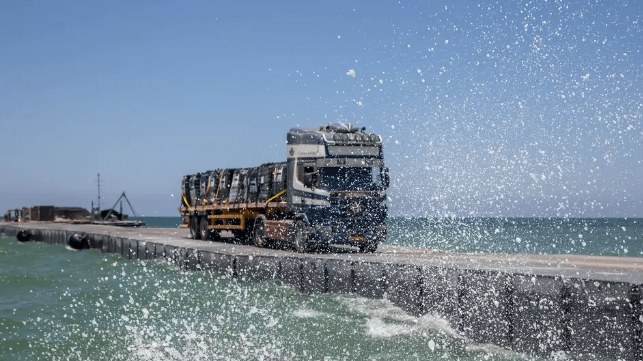Gaza Aid Pier Shuts Down Again for Maintenance

Five days after the U.S.-operated aid pier for Gaza was re-anchored at its station, its operations have been suspended once again for "scheduled maintenance activities," U.S. Central Command said in a statement Monday.
The pier was removed from the beach in anticipation of out-of-specification weather conditions on June 15. Some of its components are rated to no more than Sea State 3, and moderate swells in excess of five feet are outside of its safe operating window. The pier structure was towed to Ashdod for storage until the weather system passed, and it was re-anchored to shore on June 19.
Over the weekend, U.S. forces and their partners on shore delivered another 1,400 tonnes of aid to Gaza. The new deliveries bring the total to 6,200 tonnes - about one-tenth of one conventional Panamax bulker cargo - since launch in mid-May. When including time off hire, this is an average rate of about 11 standard aid truckload per day; the UN says that Gaza has a 500-truck-per-day requirement to adequately supply the population.
"The pier has supported a little bit, but it’s not to the scale that is needed by any stretch of the imagination," World Health Organization regional head Dr. Hanan Balkhy told the AP. "So we need to emphasize on the land routes to ensure the amount and the quantity and the efficiency."
Since the large-scale Israeli hostage rescue operation in Gaza on June 8, aid distribution from the pier's shoreside staging area has stalled over security concerns. The U.S. had tapped the UN World Food Programme to handle distribution, but WFP suspended its participation for an ongoing security review, which is now in its third week.
Israeli forces used the same beach as a landing point for a military helicopter during the June 8 hostage evacuation, and videos of a co-located Israeli military operation - which allegedly caused a substantial number of civilian casualties - raised concerns in the World Food Programme about whether the U.S.-sponsored pier could be considered a neutral aid operation, or whether UN aid workers who visited the site would be viewed as combatants simply by association. (Many Gazan residents believe that the aid pier supports Israeli military operations and view it with suspicion, especially after the June 8 helicopter landings.)
"You know, perception matters a lot," Yousef Munayyer, a senior fellow at Washington’s Arab Center, told the AP. "And for the people who are literally putting their lives on the line to get humanitarian aid moving around a war zone, perception gets you in danger."
Though the stockpile has grown in recent days, the UN World Food Programme is still not delivering it to recipients. "The question is concerns that arose over the recent weeks about the neutrality and the impartiality, in particular, of humanitarian workers and how that affects their safety," UN spokesman Farhan Haq said at a press conference last week.
Even without these concerns, Gaza is becoming more dangerous for aid workers. After months of conflict, the territory lacks an effective police force, and armed gangs have terrorized aid truck drivers and stolen cargo from convoys. The repeated attacks inside Gaza have added to the pileup of truckborne aid cargo at border checkpoints.
The desperation of local residents adds another complication to the security concerns. "One of the problems . . . is when aid gets to a place, people are starving, and they’re worried that this may be the last food that they see. They have to be assured that there’s going to be a regular flow of goods so that there’s not a panic when we get to the area," said UN spokesman Farhan Haq last week.
